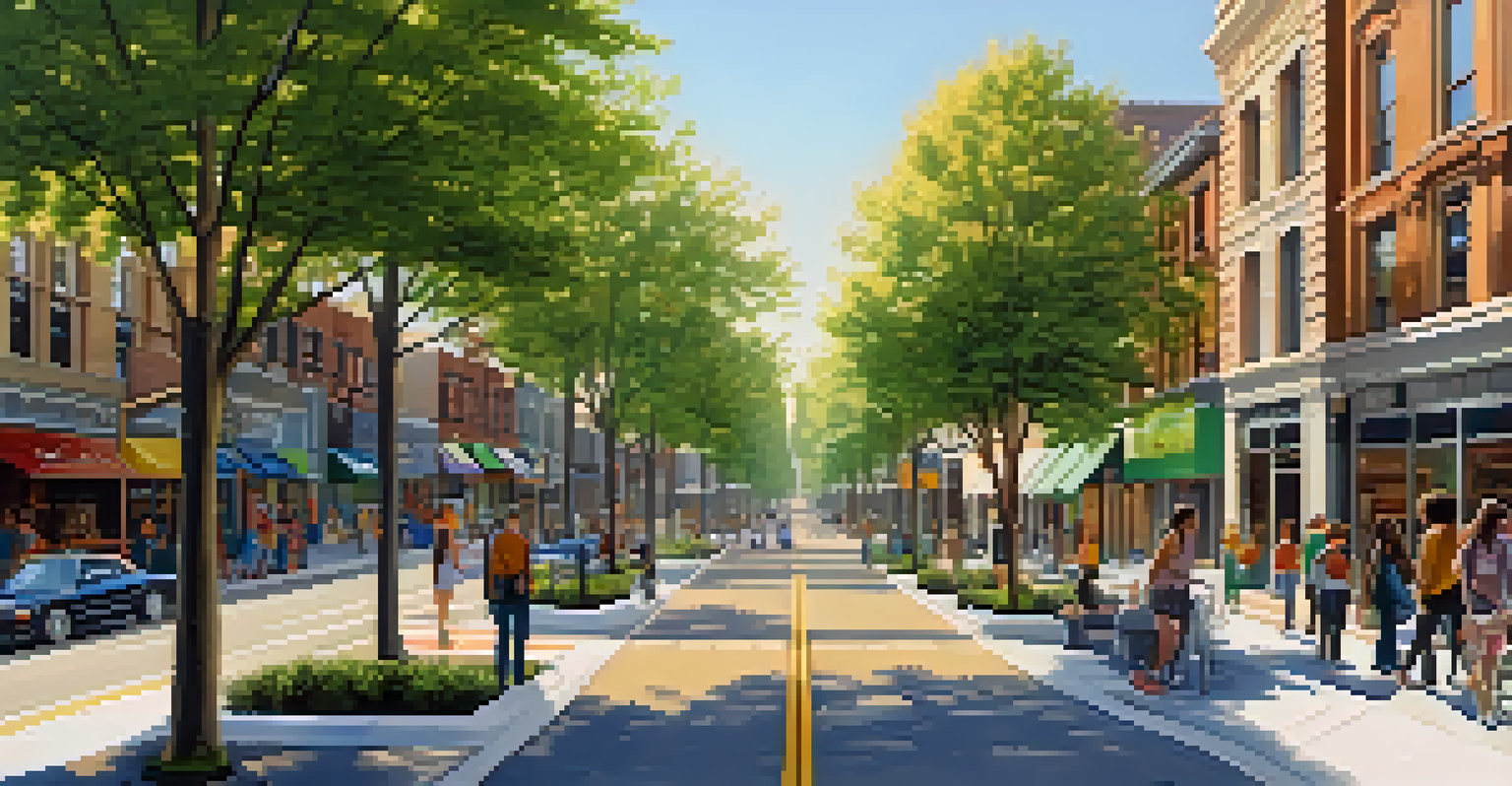The Impact of Planting Trees for Urban Cooling Effects

Understanding Urban Heat Islands and Their Effects
Urban heat islands (UHIs) are areas in cities that experience higher temperatures than their rural surroundings. This phenomenon occurs due to human activities and infrastructure, like concrete and asphalt, which absorb and retain heat. The impact of UHIs can lead to increased energy consumption, elevated emissions of pollutants, and heightened health risks for city dwellers.
The best time to plant a tree was twenty years ago. The second best time is now.
For example, during hot summer days, city centers can be up to 5°F hotter than surrounding areas. This difference can seem small but has a significant effect on the comfort and well-being of residents. Understanding these dynamics is crucial for addressing heat-related challenges in urban settings.
By recognizing the presence of urban heat islands, we can better appreciate the role trees play in combating this issue. They provide a natural solution to cooling urban environments while enhancing the overall quality of life.
How Trees Cool the Urban Environment
Trees cool the urban environment primarily through a process called transpiration. This is when trees release water vapor from their leaves, which helps to lower the surrounding air temperature. Imagine a hot day when you stand under a tree; the shade feels cooler, thanks to this natural cooling effect.

Additionally, trees provide shade, which directly blocks sunlight from hitting streets and buildings. This reduction in surface temperatures can significantly lower the overall heat in urban areas, making them more comfortable for residents and visitors alike. A well-placed tree can even lower the temperature of a sidewalk by several degrees.
Urban Heat Islands Raise City Temperatures
Urban heat islands can cause city areas to be significantly warmer than their rural surroundings, impacting energy use and health.
The cumulative effect of multiple trees can lead to noticeable temperature drops in neighborhoods, creating pleasant microclimates. This not only benefits people but also helps to mitigate the heat stress on local wildlife and vegetation.
Aesthetic and Psychological Benefits of Urban Trees
Beyond cooling, trees enhance the aesthetic appeal of urban spaces. Greenery adds beauty to concrete jungles, creating inviting environments for residents and tourists. Parks and tree-lined streets often become social hubs, encouraging community interaction and outdoor activities.
Trees are the earth’s endless effort to speak to the listening heaven.
Moreover, the presence of trees can have positive psychological effects. Studies show that spending time in green spaces helps reduce stress and improve mental well-being. Just think about how a walk in a park can lift your spirits; it’s not just the fresh air, but the calming presence of nature.
Trees also contribute to a sense of place and identity within urban areas. They can foster community pride and may even increase property values, making neighborhoods more desirable. This interplay between nature and urban living enriches our lives in countless ways.
Economic Advantages of Urban Tree Planting
Planting trees in urban areas comes with significant economic advantages. For instance, trees can reduce energy costs by providing shade to homes and buildings, leading to lower air conditioning bills during hot months. This financial relief is particularly beneficial for low-income households that may struggle with high energy expenses.
Additionally, well-maintained urban trees can enhance property values, making neighborhoods more attractive to potential buyers. Homeowners benefit from this increase in value, contributing to a healthier local economy. Think about how a tree-lined street can make a neighborhood feel more inviting and upscale.
Trees Provide Essential Cooling Effects
Trees cool urban environments through shade and transpiration, creating more comfortable microclimates and benefitting local wildlife.
Furthermore, urban trees can help mitigate stormwater runoff, reducing the burden on municipal drainage systems. This can save cities money in infrastructure maintenance and improvements, demonstrating that investing in trees is not just about aesthetics but also about long-term financial planning.
Creating Sustainable Urban Forests
To maximize the benefits of trees in cities, it's essential to create sustainable urban forests. This involves selecting the right tree species for specific environments and ensuring proper care and maintenance. Not all trees are suited for urban settings, so it's crucial to choose those that thrive in compact spaces and urban conditions.
Community involvement plays a significant role in establishing these forests. Engaging local residents in planting and caring for trees fosters a sense of ownership and responsibility, which can lead to better outcomes. Think of it as a community garden; when people invest their time and effort, they are more likely to cherish and protect it.
Moreover, urban planners and policymakers should prioritize green initiatives in their development plans. By integrating trees into urban design, cities can create more livable environments that benefit both people and nature. Sustainable urban forestry is not just a trend; it's a necessary approach for the future of urban living.
Challenges in Urban Tree Planting
Despite the numerous benefits, urban tree planting does come with its challenges. Space constraints are often a significant hurdle; cities are densely populated, leaving limited room for new trees. Additionally, existing infrastructure, like power lines and sidewalks, can complicate planting efforts.
Another challenge is ensuring the survival of newly planted trees. Urban environments can be harsh, with factors like pollution, soil quality, and limited water access affecting growth. This necessitates ongoing care and attention from local communities and municipal agencies to help trees thrive.
Community Involvement is Key
Engaging local residents in tree planting and maintenance fosters pride and stewardship, leading to healthier urban spaces.
Moreover, there can be resistance from residents who may not see the immediate benefits of tree planting. Education and awareness campaigns can help bridge this gap, showing how trees contribute to a healthier, more vibrant urban landscape. Understanding the challenges is the first step toward finding effective solutions.
The Role of Community in Tree Planting Initiatives
Community involvement is vital for successful urban tree planting initiatives. When local residents participate in planting and maintaining trees, they develop a deeper connection to their environment. This bond fosters stewardship, encouraging people to take pride in their green spaces and advocate for their preservation.
Engaging the community can involve organizing tree planting events, educational workshops, or partnerships with local businesses and schools. These collaborative efforts not only enhance community spirit but also raise awareness about the importance of trees in urban settings. The more people know, the more likely they are to support green initiatives.

Furthermore, communities can work together to create tree care programs, ensuring that newly planted trees receive proper maintenance. By pooling resources and knowledge, neighborhoods can establish a culture of care that benefits everyone. It's a win-win situation, transforming urban areas into greener, healthier places to live.